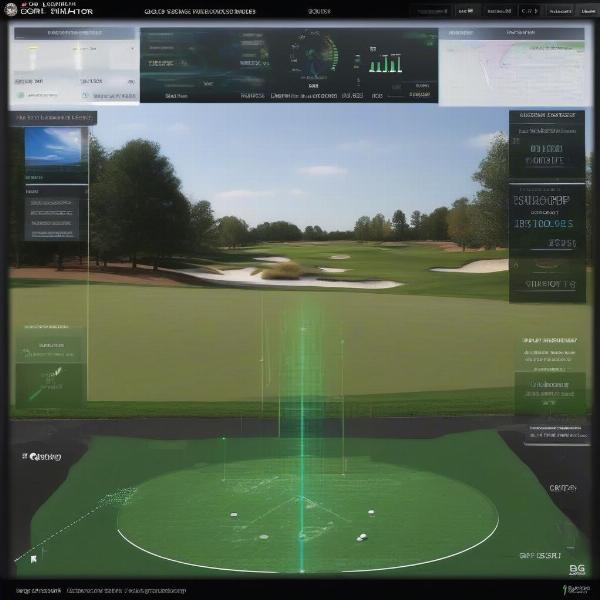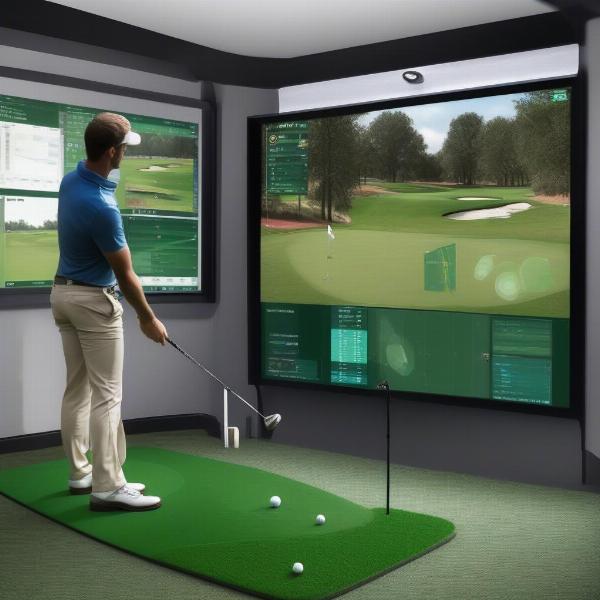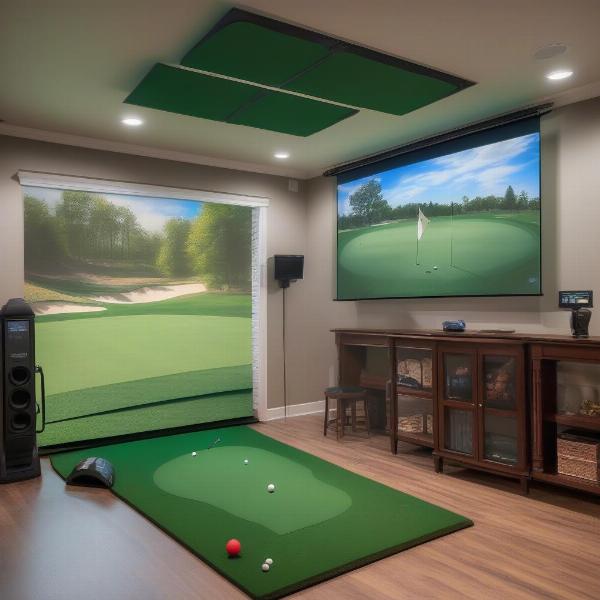At SupremeDuelist.blog, we’re always looking for ways to level up your game, and that includes the world of golf. It’s a sport that demands precision, strategy, and a lot of practice. But what if you could improve your skills without even stepping onto the green? That’s where golf simulators come into play. In this article we’ll explore whether these high-tech tools can truly help you become a better golfer.
This deep dive will analyze how golf simulators work, what aspects of your game they can enhance, and what the potential drawbacks might be. We’ll also look at different types of simulators and how to choose the best one for your needs. Ultimately, we will provide you with the information needed to understand if a golf simulator is a worthwhile investment for your golfing aspirations.
How Golf Simulators Work: A Detailed Look
Golf simulators use a combination of high-speed cameras, sensors, and computer software to create a virtual golfing experience. When you hit a golf ball into a screen, the sensors and cameras track its trajectory, speed, and spin. This data is then fed into the software, which recreates the ball’s flight on the screen, as if it was flying over a real golf course. In this virtual world you can play famous courses, practice specific shots, and analyze your swing with detailed feedback.
 Golf simulator analyzes data
Golf simulator analyzes data
This is not just a game; it’s a powerful training tool. Simulators offer a range of functionalities that can help golfers of all skill levels identify areas for improvement and refine their techniques. Some of these features are:
- Swing Analysis: Detailed data on your swing path, clubface angle, and impact position.
- Shot Tracking: Precise measurement of ball speed, distance, launch angle, and spin.
- Course Simulation: Play virtual rounds on a variety of courses from around the world.
- Practice Modes: Focus on specific aspects of your game with customized practice sessions.
The Benefits of Using a Golf Simulator
So, can a golf simulator improve your game? The answer, in most cases, is yes. Here’s why:
Consistent Practice: One of the biggest benefits of a golf simulator is the ability to practice anytime, regardless of weather conditions or time constraints. This consistency is crucial for developing muscle memory and improving overall performance. Imagine being able to hit balls even during a snowstorm!
Immediate Feedback: Unlike practicing on a driving range or the course, a golf simulator provides immediate, detailed feedback on each shot. This allows you to instantly see what you’re doing right and wrong, making the learning process faster and more efficient.
Targeted Training: With a simulator, you can focus on specific aspects of your game, such as driving, approach shots, or putting. You can also create custom practice routines, focusing on your weakest areas. This is invaluable for improving consistency and accuracy.
Data-Driven Improvement: The vast amounts of data collected by golf simulators allow you to track your progress over time. By analyzing this data, you can make informed decisions about your training and identify areas where you need to focus your efforts.
Versatile Practice: From tee shots to putting, the simulator allows you to practice every shot in golf from the comfort of your home. The ability to tailor the training to your needs is a major plus.
“The immediate and detailed feedback provided by golf simulators is invaluable. It’s like having a personal coach constantly analyzing your swing,” says Dr. Alan Reed, a sports performance analyst with over 20 years of experience. “This level of precision is difficult to achieve in a traditional practice setting.”
What Aspects of Your Game Can a Simulator Enhance?
The benefits of a golf simulator aren’t just theoretical; they translate into tangible improvements in several areas of your game:
Driving Accuracy: Analyzing launch angle and spin allows you to make adjustments to your swing that produce straighter and more consistent drives. This means fewer balls in the woods and more fairways hit.
Approach Shots: Fine-tuning your club face angle and swing path can result in more precise iron shots, helping you get closer to the pin. With data driven accuracy, you’ll be attacking flags with ease.
Short Game Mastery: Practicing chip shots and putting strokes within a simulator’s virtual environment allows you to refine your touch and develop better feel. This will greatly improve your score and overall game.
Distance Control: Understanding the nuances of your swing mechanics and the distances you achieve will lead to better club selection and distance control, whether on the fairway or the putting green.
 Analyzing golf swing on simulator
Analyzing golf swing on simulator
Potential Drawbacks to Consider
While a golf simulator offers many advantages, it’s important to also consider its drawbacks:
Cost: High-quality golf simulators can be expensive, requiring a significant investment for the initial purchase and potential software updates. This is a consideration to make before making a large purchase.
Space Requirements: Setting up a simulator requires a dedicated space, usually a room with enough height and width to swing a club and accommodate the screen and other equipment. If you do not have the room, it may not be a good fit for you.
Lack of Real Feel: While simulators have come a long way in providing a realistic experience, they cannot fully replicate the feel of a real golf course, including the different types of grass, wind conditions, and the pressure of playing a real round.
Dependence on Technology: Over-reliance on a simulator can lead to a detachment from the real game. It’s crucial to balance indoor practice with outdoor play to transfer your skills from the simulated environment to the golf course.
“Golf simulators are great tools, but they should complement, not replace, real-world practice,” advises Michael Chen, a golf coach and simulator enthusiast. “The feeling of the grass under your feet, the wind, the pressure of real competition – these are aspects that a simulator cannot fully replicate.”
Choosing the Right Golf Simulator for Your Needs
If you are considering investing in a golf simulator, here are some factors to consider when making your choice:
Budget: Golf simulators come in a wide range of prices, so it’s important to determine your budget and look for a simulator that fits it.
Features: Decide what features are most important to you. Do you want detailed swing analysis, course simulation, or both?
Space: Measure the space where you plan to set up the simulator to ensure that it fits and allows you to swing comfortably.
Technology: Different simulators use different technologies, such as radar, camera, or infrared sensors. Consider how these technologies affect accuracy, responsiveness, and overall user experience.
Software: Pay attention to the software that accompanies the simulator, as this will determine the quality of the simulation and the amount of data you receive.
Frequently Asked Questions About Golf Simulators
Can a golf simulator replace on-course practice?
While a simulator is an excellent practice tool, it should not completely replace on-course play. Real-world experience is essential for developing overall game awareness.
How accurate are golf simulators?
High-end simulators are very accurate, often matching the data you would get from professional launch monitors used by golf pros.
Are golf simulators easy to use?
Most modern golf simulators come with user-friendly interfaces, making them relatively easy to navigate and use, even for those with minimal tech experience.
How much does a good golf simulator cost?
The cost can vary from several thousand dollars for basic models to over $50,000 for professional-grade simulators. You’ll need to consider your budget and the features you require.
What kind of space is needed for a golf simulator?
A minimum ceiling height of 9-10 feet and a room width of 10-12 feet are generally recommended. Always check the manufacturer’s guidelines before setting up your simulator.
Key Questions to Answer before Buying a Golf Simulator:
How often will I use the simulator? If you don’t play often, the investment might not be worth it.
What specific areas of my game do I want to improve? Having this goal will help you choose the appropriate type of simulator.
Do I prefer a home simulator or a commercial one? Home simulators are usually more affordable and convenient for personal use, while commercial simulators offer advanced features and are used in golf centers and academies.
 Golf simulator in home environment
Golf simulator in home environment
Conclusion: Is a Golf Simulator Right for You?
Ultimately, can a golf simulator improve your game? The answer is a resounding yes, if you approach it correctly. A golf simulator provides a powerful training environment that can help you to refine your technique, improve your accuracy, and build your confidence. However, it’s important to balance this with time spent on the course to translate your improved technique into tangible results. By considering your needs, budget, and commitment, you can make an informed decision about whether a golf simulator is the right investment for you. If you’re serious about golf, it might just be the tool you need to unlock your full potential.
At SupremeDuelist.blog, we’re committed to providing you with the information you need to make informed decisions about your gaming investments. We encourage you to explore the world of golf simulators and discover how they can help you reach your peak performance. Keep checking our site for more in-depth analysis and gaming insights!
Leave a Reply